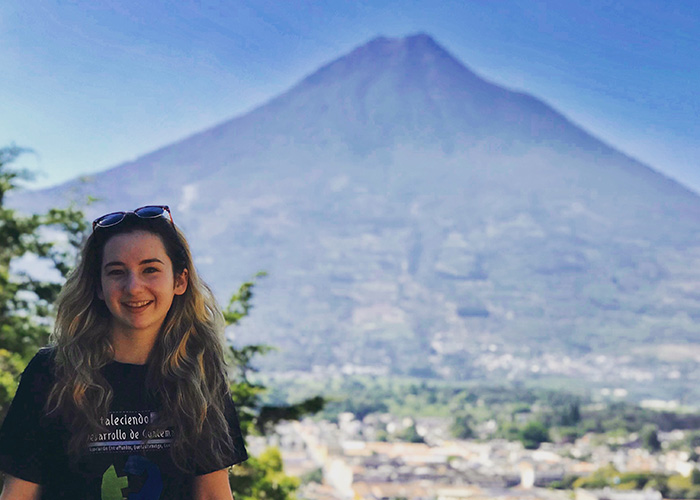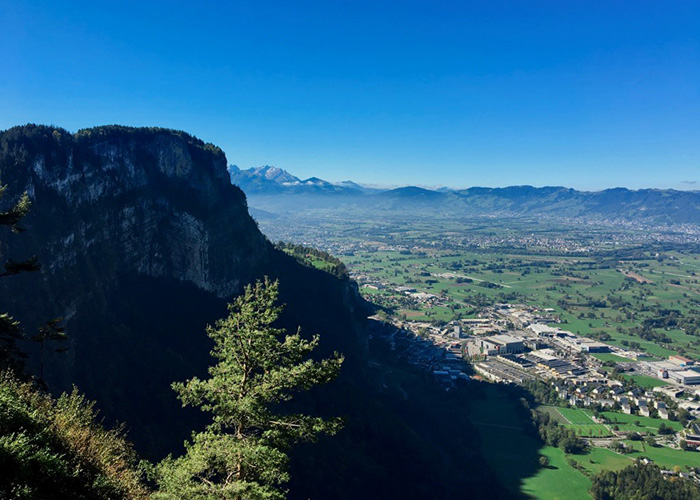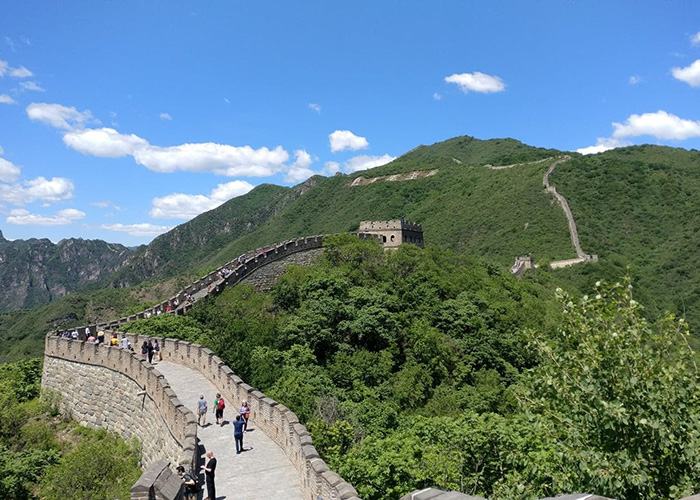Oh, the Places You’ll Go: 10 CoAS Majors Share Favorite Travel Destinations
By Kylie Gray
March 05, 2019
Sure, you could complete your whole degree in Philadelphia, but why not take advantage of Drexel opportunities around the globe? With gorgeous photos, insider tips and stories from international locales, 10 College of Arts and Sciences students share the best place their major has taken them.
1. Gran Canaria, Canary Islands

Just off the coast of northwestern Africa lies a constellation of islands with jagged terrain, black-sand beaches and balmy weather year-round. While on co-op in the Gambia, Victoria Smith, BS chemistry ’19, hopped a short flight to Gran Canaria, the third largest of the islands, for a mini getaway with her mother.
Why Gran Canaria? The people, the food and the scenery. The island is small, but teeming with different microclimates and hands down one of the most beautiful places I’ve ever visited. The south of the island is very dry with famous sand dunes, while the interior is mountainous, perfect for those who like to hike or climb. Additionally, Las Palmas, the capital of the island, is an amazing city — impeccably clean, walkable and bike friendly, with amazing food, nightlife and one of the world’s most pristine urban beaches, Playa de las Canteras.
Can’t-Miss Activity: We did two hiking day-trips with a small group tour company called “Excursions Gran Canaria.” Pavel, the guide, was incredibly knowledgeable, and the tours were a fun and affordable way to see the island. I would recommend Pavel’s tours to everyone visiting Gran Canaria.
Insider Tip: Gran Canaria has as great bus system, with buses that take you directly from the airport to downtown, as well as all the way across the island. If you’re traveling on a budget, you can definitely get around using public transportation.
2. Muscat, Oman

A relaxed, seaport city hemmed by the Hajar mountains, Muscat is the capital and largest city in the Middle East’s Oman. While studying abroad in Dubai, sociology major Amna Khalafalla ’21 boarded a six-hour bus to Muscat and spent three days there.
Why Muscat? It is the most beautiful of the Gulf Arab countries. Its leader, Sultan Qaboos, is fixed on modernizing the country but also keeping it very traditional, which I really love! It also has a diverse ethnic make-up with African and Southeast Asian Arabs.
Can’t-Miss Activity: Hiking! Oman generally has amazing hiking spots, many valleys and breathtaking views. I recommend spending a day in Wadi Shab.
Insider Tip: Since Muscat is a rural city, I recommend exchanging currency before you get to Oman, as ATMs aren’t available everywhere. Also, everything closes at around 8 or 9 p.m., so do all your activities in the morning or afternoon.
3. Guatemala

The Central American country of Guatemala is home to a diverse culture rooted in its Mayan ancestry — along with memorable sites like volcanoes, rainforests and ruins. As part of an Intensive Course Abroad, global studies senior Lindsay Morrissey worked with a Guatemala-local NGO to assist with development projects and learn about indigenous Guatemalan culture.
Why Guatemala? Many communities in Guatemala have preserved their customs and traditions, and there is an authenticity about their culture that is hard to find in other cities abroad. Many of the women and men still wear traditional clothing, English is hard to come by, and the art is local and handmade.
Can’t-Miss Activity: Kayaking on Lake Atitlan and visiting local shops in the surrounding villages. Visit Antigua and hike to Cerro de la Cruz for the best view of the city!
Insider Tip: Try to experience as many cultural activities as you can. Guatemala has a beautiful indigenous community that still uses traditional methods for chocolate making and weaving textiles.
4. Paris, France

One of the world’s most visited cities, Paris is known for its elegant style, iconic landmarks and romantic banks on the historic River Seine. Math major Patrick Lombardo ’19 has co-oped in Greece and completed an Intensive Course Abroad in Italy, but says his study abroad in Paris made “La Ville Lumière” particularly special to him.
Why Paris? I really love French language and culture and the Parisian way of life. Most of all though, I made some lifelong friends with whom I have a special relationship.
Can’t-miss activity: Biking with the Vélib bike share program is the best way to see the city. Turn off your phone, grab a bike and ride around randomly, just taking it in. In Paris, you’ll find what you’re looking for much faster by chance than by actively looking for it.
Insider tip: Don’t come with expectations. Paris can be unforgiving, and you may hate it — but if you can take off your rose-tinted glasses and see it for what it is, it’s a beautiful city.
5. Kolkata, India

India’s second-largest city, Kolkata is replete with cultural institutions, a vibrant arts community and distinct, 19th century architecture. Environmental science major Farzana I. Rahman ’17, spent the spring break following a Global Environmental History course in Kolkata — where the group met prominent Indian scholars, historians and scientists; grappled with the challenges of globalization; and attended countless cultural functions.
Why Kolkata? Our itinerary included a visit to the East Kolkata Wetlands (EKW) with the now late Dr. Dhrubajyoti Ghosh, a brilliant scientist who helped people understand the science behind the traditional method of wastewater treatment in the EKW. In addition to providing Kolkata with an “ecologically subsidized” form of sewage treatment, the EKW also supports hundreds of diverse species and plays a crucial role in flood control. As a student involved in wetland research here at Drexel, I cherished the time I spent with Dr. Ghosh in the EKW.
Can’t-Miss Activity: Kolkata is brimming with life, and there are so many things to enjoy — food, history, language, culture. I recommend watching the high tide come in from one of the many ghats in the city. Situated on the banks of the Hooghly River, a tributary of the Ganges, the city has long been influenced by the ebb and flow of the river. The intensity of the water as the tides come in really makes it feel as if the river has a personality; that it is playful but potent.
Insider Tip: Come with a sense of wonder.
6. Seoul, South Korea

Futuristic infrastructure, red-hot fashion, and, of course K-Pop — Seoul is a tourist-favorite big city with activity around the clock. As a Freeman-ASIA awardee, global studies major Gianna Manela ’22 spent the fall term in the South Korean capital, studying Korean language and history at Seoul National University.
Why Seoul? Seoul is a city filled with amazing people, food, views and culture. Those I met while on exchange are a huge reason Korea is so special to me now; I also did a tremendous amount of internal growth in this city. I’ll never forget my time there and its impact on me.
Can’t-Miss Activity: You absolutely must experience nightlife in Seoul! Grab a huge group of friends, go out to eat, hit up clubs in Hongdae, Itaewon, etc., and make sure to stay out ’til first train — it’ll be a night you never forget!
Insider Tip: My biggest piece of advice is to never let the fear of a language barrier hold you back; people in Seoul are so very patient and understanding with foreigners! Another thing is to make sure you have the following apps downloaded on your phone: KakaoTalk, KakaoMetro, AirVisual, and NaverMaps or KakaoMaps (for messaging, air quality, subway and navigation). Trust me: You’re going to need them until you get comfortable finding your way around the city.
7. Dornbirn, Austria

Dornbirn: a hiking destination, commercial hub and, of course, the birthplace of A.J. Drexel’s father, Franz Martin Drexel! Mae Madrigal, a senior history major, was lucky enough to go on a trip — organized by Scott Knowles, PhD, department head and professor of history, and Eric Zillmer, PsyD, professor of neuropsychology and director of athletics — aimed at strengthening Drexel’s ties with the city and its archives.
Why Dornbirn? Austria, and especially the Vorarlberg region, is unique because of its location. From the top of Mount Karen, where the photo is taken, you can see three different countries, as well as Lake Constance. Austria is heavily influenced by Swiss and German culture, which makes for amazing cuisines.
Can’t-Miss Activity: Take the cable car up Mount Karen and enjoy a meal outside. The food is amazing, and the view is breathtaking.
Insider Tip: Many of the restaurants do not have English menus, so don’t be afraid to ask what the entrée is and how it’s made. Some of my best meals ever were from traditional Austrian cuisine.
8. Chile

Stretching down the southwestern coast of South America is a country known for its diverse climates and breathtaking terrain. It’s where global studies major Anthony Perez ’20 took his first Drexel abroad trip, and where learning Spanish, making friends, and cooking for himself helped him gain confidence in his abilities.
Why Chile? Chile holds a special place in my heart because it is where I met and fell in love with my current boyfriend of two years, and why I go back every now and then. The most shocking things occur when you least expect it. We made things work and already have plans to travel to New Zealand together after graduation!
Can’t-Miss Activity: The number one thing I recommend for ANYONE visiting Chile is to take advantage of Chile’s drastic variety in landscapes and environments. The country has everything from the warm deserts of San Pedro de Atacama in the north to the icy glaciers of the Torres del Paine in the south, with volcanoes, lush forests, beautiful beaches, tall mountains and hot springs in between.
Insider Tip: Visitors should know that the Spanish you may learn in the classroom will not completely prepare you for vocabulary in this country. There are online dictionaries to help you prepare, but I found learning the local words and phrases to be fun and entertaining, and have never met a Chilean who did not enjoy explaining their extensive vocabulary.
9. China

Home to diverse cultures and nearly one-fifth of the world’s population, China uniquely combines ancient traditions with modern industry. Biological sciences major Shreeya Agrawal ’19 has completed a few study and co-op abroad experiences, but says that China — where she worked as a patient advocate with the United Foundation for China’s Health for her second co-op — was her favorite destination.
Why China? Interacting and working with people in a different culture, learning a new language and enjoying good food made China particularly memorable for me.
Can’t-Miss Activity: Travel and explore at least one part of China other than the city you are working or studying in. I went to a few different places in northeast China, and it was an amazing experience.
Insider Tip: Learn a bit of Mandarin, especially common street food names, and use Pleco (a Chinese dictionary and translation app).
10. Norway and Sweden

Along with stunning glacial landscapes and top quality-of-life rankings, the Scandinavian region of Europe is known for its innovative approaches to criminal justice reform. During an Intensive Course Abroad focused on comparative justice systems, criminology and justice studies major Yih-Chia Lam visited the “world’s most humane prison” in Norway and a juvenile correctional facility in Sweden — and enjoyed the trip so much that she went back the following year.
Why Scandinavia? The primary difference is in the justice system, which is evidence-based and focused on social work and offender rehabilitation rather than punishment. There’s even a term for it: “Scandinavian exceptionalism.” In terms of day-to-day life, what stood out to me most was how clean and efficient everything was, especially in public spaces.
Can’t-Miss Activity: If you visit during December, the Christmas markets are the number one place to visit. While they do share similarities with the Christmas Village in Philadelphia, in Scandinavia you can get elk burgers, ride a giant Ferris wheel, and buy exquisite Sami handicrafts from the indigenous people.
Insider Tip: Sweden and Norway are cashless societies, so there’s no need to exchange currency. Just remember to bring credit cards. One major thing to keep in mind is that Scandinavians are polite and quiet in public spaces, so try to keep your voice down.
Ready to embark on your own international adventure? Learn about Intensive Courses Abroad and study abroad through the Education Abroad Office, international co-op opportunities through the Steinbright Career Development Center, or more global opportunities through the College of Arts and Sciences.